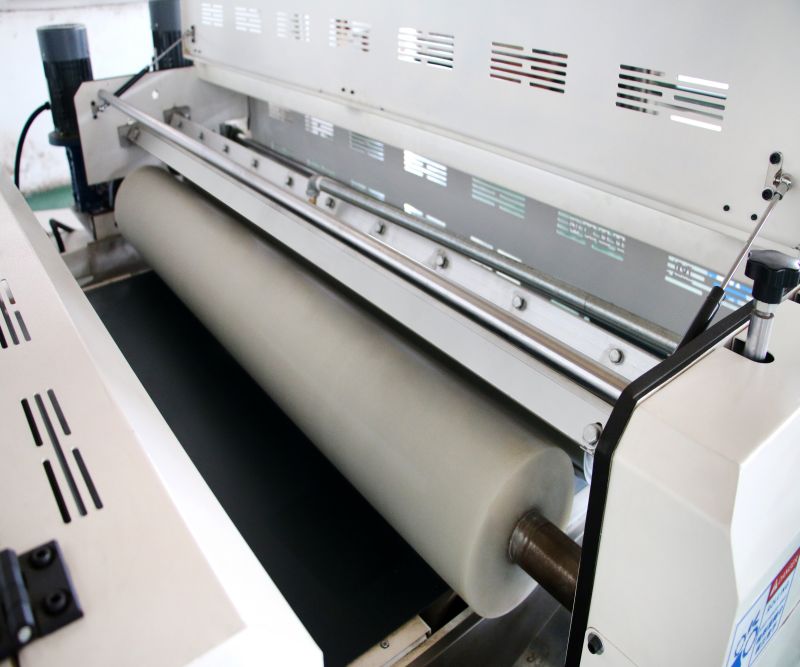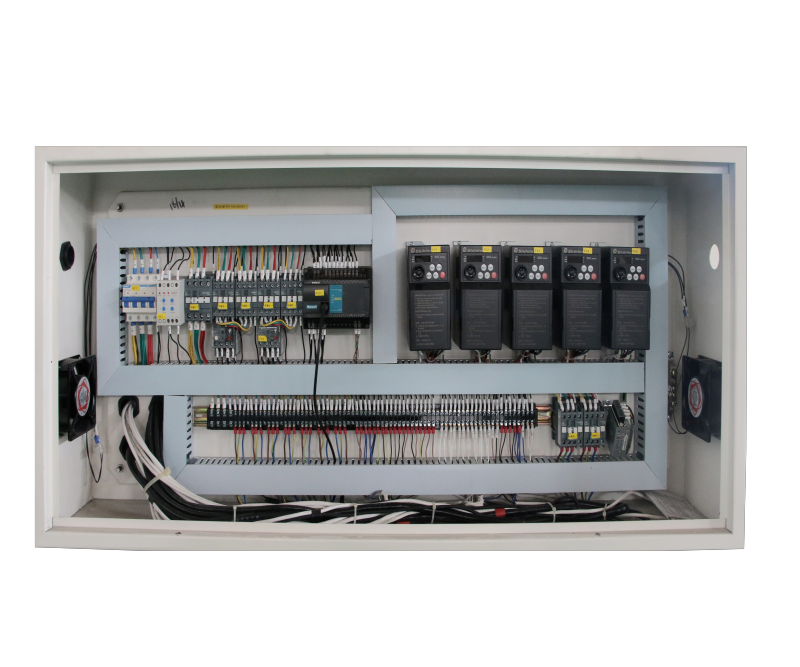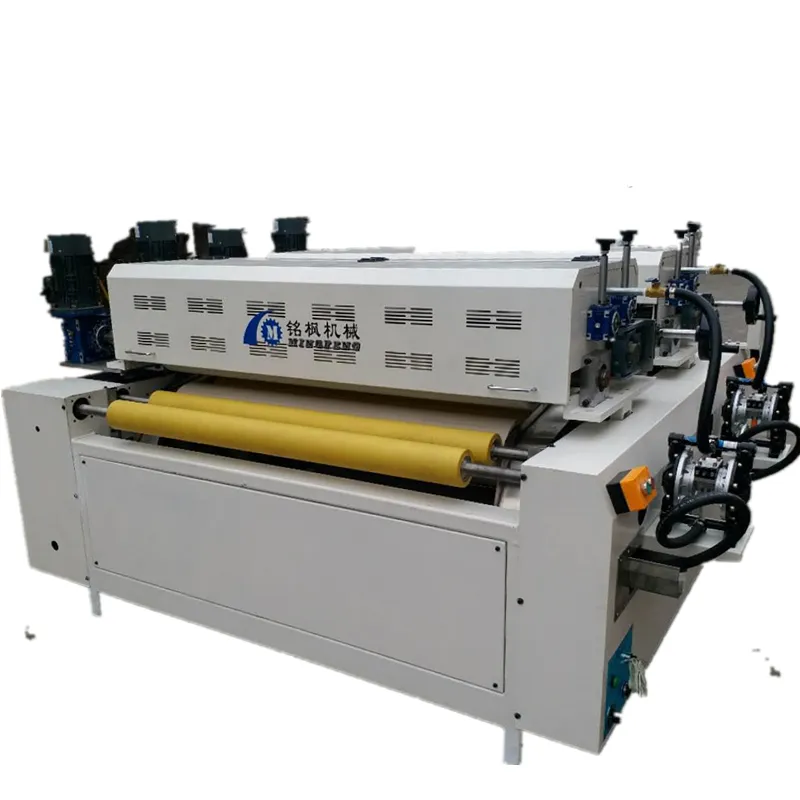In modern industrial manufacturing, coating processes are widely used in the surface treatment of various materials. Coating not only affects the product's appearance but also directly impacts its physical properties, functionality, and service life.
Among various coating equipment types, roller coating machines are a common and efficient type, widely used for coating paper, metal sheets, plastic film, leather, wood, fiberglass, and other materials.
This article will systematically explain what a roller coating machine is, including its structural principles, operating methods, main components, classification methods, technical specifications, applications, and its main functions in actual production.
What is a roller coating machine?
A roller coating machine uses rotating rollers to evenly apply liquid coating to a material's surface. Its basic principle is to achieve a quantitative and uniform coating on a substrate through the contact, squeezing, spreading, and transfer effects of one or more rollers.
Compared to other types of coating equipment (such as blade coating, spray coating, and dip coating), roller coating machines offer significant advantages such as ease of operation, uniform coating, wide applicability, and high coating speed. They are particularly suitable for industrial production scenarios requiring large-scale continuous coating.
What does a roller coating machine consist of?
A standard roller coating machine primarily consists of several core components: a conveyor system, a coating roller system, a paint supply system, a temperature control system, and a control system.
1. Conveyor System
The conveyor system is used to smoothly and continuously transport the substrate to be coated into the coating area. Common conveyor methods include flat conveyor belts, roller conveyors, or vacuum conveyors. Its operating speed must match the coating speed to ensure uniform coating.
2. Coating Roller System
The coating roller system is the core component of the equipment and typically includes:
·Coating Roller: This is responsible for transferring the coating directly to the substrate surface. Its material and surface treatment have a significant impact on coating quality.
·Metering Roller: Used to control coating thickness and prevent excess coating from remaining on the coating roller.
·Feed Roller/Doctor Blade: Used to feed coating material to the coating roller or remove excess coating.
·Backup Roller: Supports the substrate and provides a stable contact surface, facilitating coating force control.
3. Paint Supply System
This system includes a paint storage tank, a feed pump, a paint filter, and a piping system to ensure a stable flow and pressure of paint to the roller surface.
4. Temperature Control System
Because some coating materials are temperature-sensitive during the coating process, the roller surface is typically equipped with cooling/heating devices to control its temperature and ensure optimal viscosity.
5. Control System
Modern roller coating machines are typically equipped with automated control systems, including PLC controllers, touchscreen displays, coating thickness sensors, and tension controllers, enabling high-precision automated control.

How does a roller coating machine work?
The operating principle of a roller coating machine is based on the transfer coating mechanism. The operating process can be briefly described as follows:
1. The paint is delivered from the feed system to a metering roller or trough;
2. The coating roller contacts the paint as it rotates, and a layer of paint is absorbed onto its surface;
3. The metering roller or scraper removes excess paint, forming a uniform coating;
4. The coating roller contacts the substrate, transferring the paint to its surface;
5. The substrate then enters a drying or curing process, completing the coating.
The uniformity of the coating depends on parameters such as the pressure between the rollers, the gap, the speed ratio, the paint viscosity, and the surface tension.
What are the types of roller coating machines?
Based on their technical structure and coating principle, roller coating machines can be divided into four types:
1. Forward roller coating machine
2. Reverse roller coating machine
3. Dual roller coating machine
4. Multifunctional composite roller coating machine
1. Forward roller coating machine
In this type, the coating roller rotates in the same direction as the substrate, and the paint is applied directly from the roller surface to the substrate surface. This method is suitable for thin, high-precision coating.
2. Reverse Roller Coating Machine
In reverse coating, the coating roller rotates in the opposite direction of the substrate, achieving a thinner, more uniform coating through greater shear force. This makes it suitable for high-precision or multifunctional coatings.
3. Dual Roller Coating Machine
Two or more rollers work together to achieve multi-layer coating or more complex coating processes.
4. Multifunctional Composite Roller Coating Machine
Combines different roller coating methods (such as reverse and forward), and is equipped with additional equipment such as scrapers, calendars, and dryers. It is used for coating high-end composite materials.

What are the technical specifications of roller coating machines?
The performance of a roller coating machine is influenced by several technical parameters, including the following:
· Coating width: This indicates the maximum width of material that the roller can effectively coat;
· Coating speed: This refers to the linear speed of the substrate during the coating process, typically measured in meters per minute;
· Coating thickness control range: This refers to the range of thinnest to thickest coatings achievable by different equipment, typically ranging from a few microns to hundreds of microns;
· Roller diameter and hardness: This affects coating pressure and contact area;
· Metering method: This includes blades, metering rollers, and gap control;
· Tension control accuracy: This affects coating uniformity and substrate stability.
What materials and coatings are suitable for roller coating machines?
1. Applicable Substrates
The roller coating machine is suitable for a variety of flexible and semi-rigid materials, including:
· Paper (coated paper, thermal paper, etc.)
· Plastic film (PET, BOPP, PVC, etc.)
· Aluminum foil, copper foil, steel plate
· Wood, density fiberboard, decorative board
· Non-woven fabrics, fabrics
· Glass fiber, carbon fiber prepreg, etc.
2. Coating Types
It can be used to apply a variety of coatings, including:
· Oil-based paints, water-based paints
· UV-curable paints
· Adhesives (pressure-sensitive adhesives, hot-melt adhesives, etc.)
· Release coatings, waterproof coatings, antistatic coatings
· Functional coatings such as thermal insulation, conductive, and flame retardant coatings
What is the function of a roller coating machine?
Roller coating machines play a key role in various production processes:
1. Improving product surface quality
2. Imparting specific functionalities to materials
3. Providing protection
4. Achieving structural composites
5. Improving production efficiency
1. Improving product surface quality
Coating can create a smooth, uniform appearance on substrate surfaces, enhancing both visual appeal and tactile feel. It is particularly suitable for industries with high surface quality requirements, such as packaging, home appliances, and building materials.
2. Imparting specific functionalities
Using different coating formulations, roller coating machines can impart properties such as conductivity, water resistance, fire resistance, scratch resistance, barrier properties, and printability to materials, enabling them to meet specific application requirements.
3. Providing protection
Coatings effectively shield materials from external factors such as moisture, oxygen, UV rays, and chemical corrosion, extending their service life and improving product stability.
4. Achieving structural composites
In the composite material manufacturing process, roller coating machines are often used for sizing, bonding, and priming, enabling lamination or bonding of different materials and providing the foundation for composite processes.
5. Improve Production Efficiency
Roller coating machines support high-speed continuous operation, making them suitable for large-scale production. Combined with automated control, they can significantly reduce labor costs and improve production stability.

What are the advantages and disadvantages of roller coating machines?
Advantages of roller coating machines:
·High coating precision, suitable for mid- to high-end product requirements;
·Strong coating uniformity, compatible with a variety of coatings and substrates;
·Can be integrated with various drying methods (hot air, infrared, UV) to form an integrated process;
·Easy to adjust to meet the needs of different product batches;
·Can be integrated with printing, laminating, cutting, and other process lines for one-stop processing.
Disadvantages of roller coating machines:
·High requirements for coating viscosity and rheological properties;
·Requires certain substrate flatness and thickness;
·Relatively high equipment investment, requiring professional maintenance;
·Certain complex or uneven substrates are not suitable for roller coating.
Roller Coating Machine Information Summary Table
Classification | Projects | Description |
| Definition | Roller coating machine | A device that uses a rotating drum to evenly apply liquid coating to a material surface |
| Main Function | Surface treatment, functional enhancement, protection, composite processing, and increased productivity | / |
| Structural Composition | Conveyor system | Substrate conveying, ensuring stable input and output |
| Coating roller system | Coating drum, metering drum, feed/scraper drum, carrier drum, etc | |
| Paint supply system | Paint tank, pump, filter, and delivery piping | |
| Temperature control system | Drum temperature control to adjust coating fluidity and stability | |
| Control system | Automation modules including PLC, touch screen, thickness control, and tension adjustment | |
Working Principle | The paint is transferred to the substrate surface by the roller, and a uniform coating is formed by controlling the pressure and speed | / |
| Main Types | Forward Coating Machine | The roller rotates in the same direction as the substrate, suitable for thin, uniform coating |
| Reverse Coating Machine | The roller rotates in opposite directions, providing strong shear force and enabling high-precision coating | |
| Dual Roller Coating Machine | Two or more rollers work together for multi-layer or composite coating | |
| Multi-function Laminating Machine | Equipped with various functional modules, suitable for complex process lines | |
| Technical Parameters | Coating Width | Sizes such as 600mm, 1300mm, and 1800mm can be customized based on the substrate |
| Coating Speed | Typically, the speed is 5–100 m/min, depending on process requirements | |
| Coating Thickness | The adjustable range is generally from 2 μm to several hundred μm | |
| Roller Diameter/Material | Depending on pressure and coating uniformity, chrome-plated or rubber-plated materials are commonly used | |
| Temperature Control Range | Suitable for temperature control during the processing of water-based, oil-based, and UV coatings | |
| Applicable Substrates | Plastic film | PET, PVC, BOPP, etc. |
| Metal materials | Copper foil, aluminum foil, stainless steel sheet, etc. | |
| Wood/board | MDF, particle board, decorative panels, etc. | |
| Paper | Coated paper, thermal paper, wrapping paper, etc. | |
| Fiber materials | Non-woven fabrics, fiberglass fabrics, carbon fiber fabrics, etc. | |
| Applicable Coatings | Water-based/oil-based coatings, UV-curing coatings, adhesives, functional coatings (such as conductive, fire-retardant, waterproof, etc.) | / |
| Advantages | Uniform coating, high precision, wide application range, suitable for large-scale continuous production | / |
| Disadvantages | Not suitable for concave and convex materials, has requirements for coating viscosity, and the equipment cost is relatively high | / |
How do I know if your coating line design will match my production needs?
XMF Machinery carefully evaluates your substrate type, coating chemistry, desired throughput, and space constraints to design tailored production lines. As a professional manufacturer and supplier, we deliver a scientific, customized proposal complete with equipment layout, machine specifications, required coatings, and line flow.
Once approved, we provide quotes with clarifications, prices, and volume discount terms. You can buy with confidence that the equipment suits your materials and objectives, backed by our technical service.
